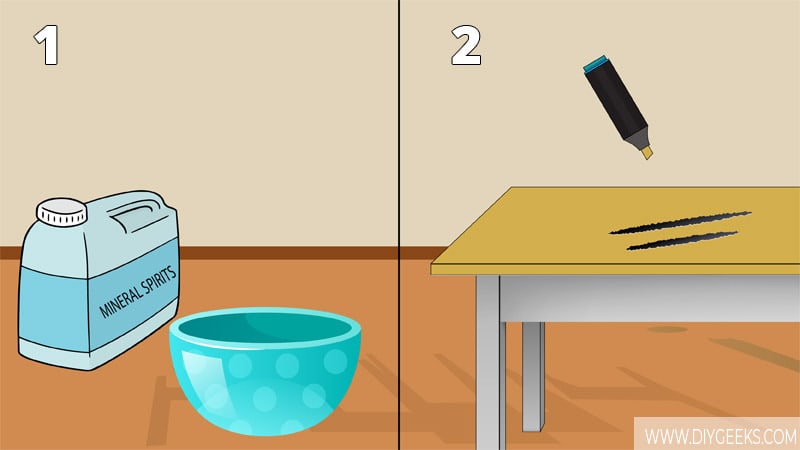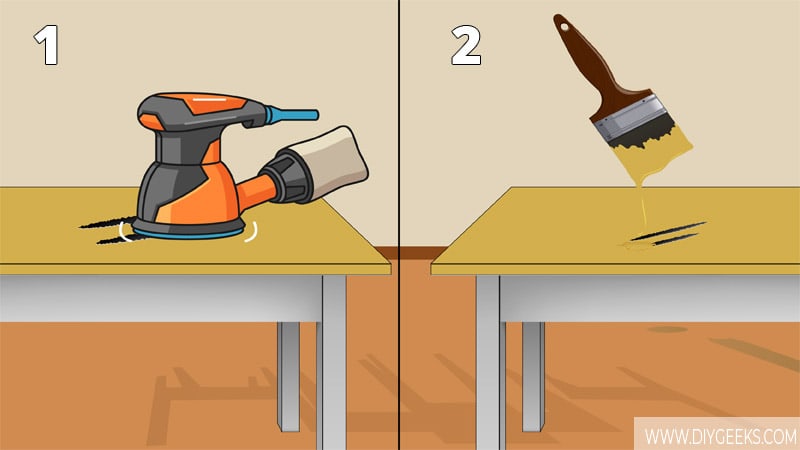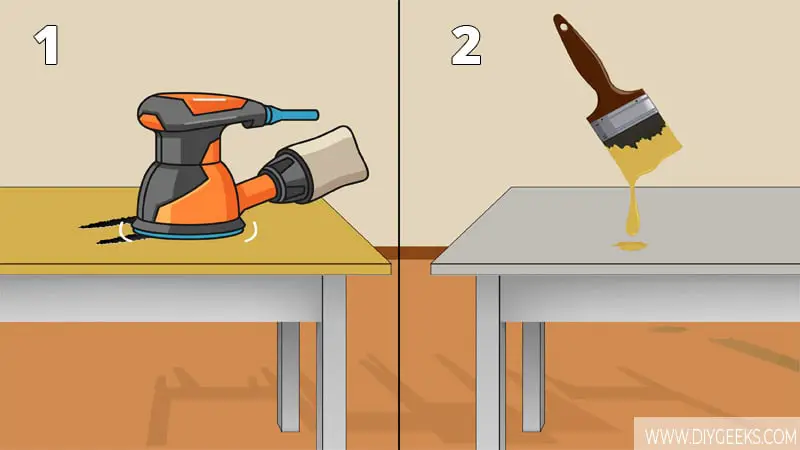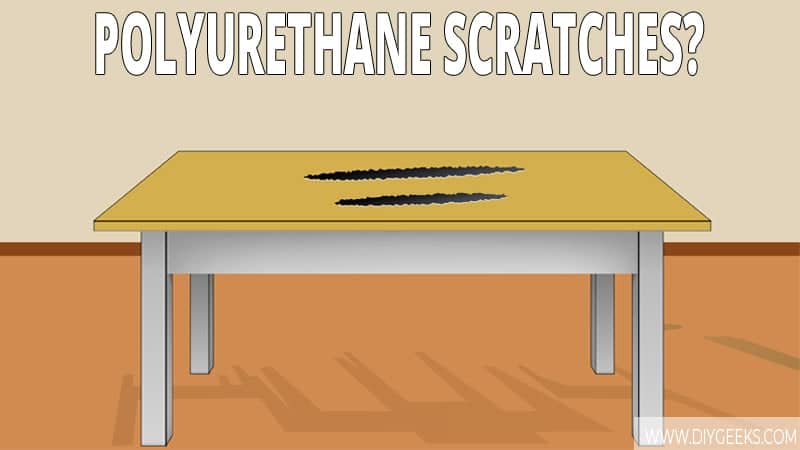To fix light polyurethane scratches, use a polyurethane marker pen. To fix layer scratches, sand the finish until it’s leveled with the scratch, and apply three coats of polyurethane.
To fix deep polyurethane scratches, remove the entire finish, apply wood filler, and re-apply the sealer.
Why Does a Polyurethane Finish Scratch?
A polyurethane finish scratches because of wear and tear, pet claw marks, toys, cleaning products, wrong sandpaper, filthy surfaces, or wrong cleaning attachment.
Over time, a polyurethane finish will develop scratch marks due to friction, dropped items, pencil marks, etc.
Here are some other reasons why this happens:
- Pet Claw Marks – If you have a pet cat or dog, your pet’s claws can scratch your polyurethane finish. This isn’t limited to floor surfaces, because your pet can pounce on a finished desk and scratch it. The best way to avoid this is to trim your pet’s claws frequently.
- Toys – Dragging toys across the floor or table can cause scratches on the finish. Luckily, these are light scratches and can be fixed easily.
- Cleaning Products – If you clean a polyurethane finish with the wrong cleaning products, it can cause scratches on the finish. Some cleaning products can dissolve and soften the polyurethane finish. When this happens, the finish will develop scratches from the lightest touches.
- Wrong Sandpaper – You must sand between coats of polyurethane with fine-grit sandpaper. But, if you use medium or coarse-grit sandpaper, the finish will reveal scratches. If you use the wrong sandpaper too much, you can ruin or remove the entire finish.
- Filthy Surface – If the floor is filthy or filled with sand grains, you can scar the finish. While walking, you can push and drag the sand grains into the polyurethane finish and create a rough finish.
- Wrong Cleaning Attachment – You can scar a polyurethane finish while cleaning the floor with abrasive or spiky cleaners.
Can You Touch Up Polyurethane?
You can only touch up a polyurethane finish if it has a coating scar. If the mark has only affected the coating and not the surface underneath, you can touch up the finish with an extra coating or a scratch-repair pen.
You can apply a new coating of polyurethane to fill and cover the affected spots. But, you must sand the existing finish before applying the new coating. Sanding will remove grime and bumps and help the new coating to stick better.
You can touch up polyurethane with a scratch-fix PU pen or a scratch-repair marker, too. These markers are filled with a mix that fits all types of clear coats. You just need to pick the pen with the same color or shade as your existing finish.
You can’t touch up polyurethane if the scar is deep and has penetrated the wood surface. That’s because the scar is too deep for the touch-up to cover or fix it. In this case, you must remove the entire finish, apply wood filler, and re-apply it.
How To Fix Scratches On a Polyurethane Finish?
To fix scratches on a Polyurethane finish, do the following things.
- Use a Scratch-fix Pen.
- Sand and Touch up the Finish.
- Strip and Re-Seal the Wood.
Before you can fix scratches in polyurethane finish, you must know their type:
- If the abraded spot looks darker than the surrounding finish — it’s a deep mark, and you must strip and re-seal the wood to fix it.
- If the scratch spot has the same color as the finish — it’s a surface scratch and can be touched up.
- Is the wood stain underneath affected? – It’s a film scratch, and sanding is required.
- Wipe the abraded spot with mineral spirits — if it comes off, it was just a stain.
1. Use a Scratch-fix Pen

To fix a light-abraded spot on a polyurethane finish, use a polyurethane marker pen. The marker pen is filled with a mixture that will fill and cover the scratched mark.
The tools you need for this project are listed below.
- Scratch repair polyurethane marker/pen
- Clean rags
- Mineral spirits
- A clean bowl
Here is a guide for this fix:
- Damp a rag with mineral spirits.
- Use the dampened rag to wipe the abraded spot on polyurethane.
- Place the tip of the polyurethane marker pen where the scratch spot begins.
- Press the marker pen to release the mixture.
- Move the pen along the scratch line while pressing it.
- Stop at the end of the scratch, and wipe the pen’s tip with a rag.
- Wipe the surface to remove excess filler.
- Leave the spot to dry.
- Once dry, sand the spot with very fine-grit sandpaper.
- Wipe the dust off, and the scratch should be removed.
2. Sand and Touch up the Finish

When the abraded spots have penetrated the polyurethane finish but not the wood or stain, it’s a layer scratch. To fix a layer scratch, sand the surface to level the area and apply three (3) coats of polyurethane.
The tools you need for this project are listed below.
- Polyurethane paint
- 320-grit sandpaper
- Clean rags
- A paintbrush
The steps for this project are listed below.
- Wipe and clean the affected spot.
- Sand polyurethane with fine-grit sandpaper.
- While sanding, inspect the surface often, so you don’t sand into the wood.
- When you have leveled the polyurethane with the depth of the scratch, stop sanding.
- Remove dust.
- Re-apply 1-2 coats of polyurethane.
- Leave the finish to dry.
3. Strip and Re-Seal the Wood

If the abraded or scratches spots have affected the wood, remove the polyurethane, apply wood filler, and re-seal the wood. These deep gouges on wood are often caused by dropped items or heavy furniture.
The tools you need for this project are listed below.
- Sandpaper of different grits
- Wood filler
- Polyurethane paint
- Paintbrushes
- Wood stain (optional)
Here is a guide to this method:
- Remove polyurethane by sanding or applying a paint-stripping paste.
- Fix scars in the wood with wood filler.
- Sand wood with fine-grit sandpaper to remove imperfections.
- Remove dust.
- Apply wood stain (optional).
- Re-apply polyurethane.
- Allow the finish to dry.
Can You Fix Scratches Between Polyurethane Coats?
You can’t fix scratches between polyurethane coatings without removing at least one coat.
If you notice a scratch on the polyurethane finish, you must sand it until it’s leveled with the scratch. Afterward, you must fill or fix the spot and re-apply the sealer.
You can’t fix the scratch by applying more polyurethane if the scratch is between coats. That’s because polyurethane is a clear coat and will show imperfections, such as abraded spots after it dries.
To hide abraded spots between coats of polyurethane, you must apply a tinted polyurethane coating. The tinted finish will hide the abraded spots, making the surface look smooth.
How To Prevent Polyurethane Scratches?
To prevent polyurethane scratches, do the following things.
- For floors, place a transparent carpet over the finish to protect it from scratch marks.
- Don’t drag items across the polyurethane finish.
- Always use the right sandpaper while sanding the finish.
- Don’t use the wrong cleaning products as they can soften the finish, making it more prone to scratches.
- Don’t use abrasive pads or cleaners while cleaning the surface.
- Wipe and clean the finish regularly.


